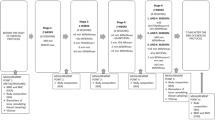Abstract
The purpose of this prospective study was to determine whether moderate walking exercise in postmenopausal women with osteopenia/osteoporosis would affect bone metabolism. Fifty postmenopausal women, aged 49–75 years, with osteopenia/osteoporosis were recruited: 32 women entered the exercise program (the exercise group) and 18 served as controls (the control group). The exercise consisted of daily outdoor walking, the intensity of which was 50% of maximum oxygen consumption, with a duration of at least 1 h with more than 8000 steps, at a frequency of 4 days a week, over a 12-month period. Lumbar (L2–L4) bone mineral density (BMD) was measured at the baseline and every 6 months with dual-energy X-ray absorptiometry (DXA) in both groups. Serum bone-specific alkaline phosphatase (BAP) and urinary cross-linked N-terminal telopeptides of type I collagen (NTX) levels were measured at baseline and at months 1, 3, 6, 9, and 12 by EIA and ELISA, respectively, in the exercise group, and urinary NTX level was measured at the baseline and every 6 months in the control group. There were no significant differences in baseline characteristics including age, height, body weight, bone mass index, years since menopause, lumbar BMD, and urinary NTX level between the two groups. Although no significant changes were observed in lumbar BMD and the urinary NTX level in the control group, lumbar BMD in the exercise group was increased as compared with the control group, but was sustained from the baseline. In the exercise group, the urinary NTX level rapidly responded to walking exercise from month 3, and this reduction was sustained until month 12, followed by reduction in the serum BAP level. A moderately negative correlation was found between the percent change in the urinary NTX level at month 3 and that in lumbar BMD at month 12 in the exercise group. This study clearly demonstrates that the mechanism for the positive response of lumbar BMD to moderate walking exercise in postmenopausal women with osteopenia/osteoporosis appears to be the suppression of bone turnover, and that an early change in the urinary NTX level may be useful to predict the long-term response of increasing lumbar BMD to exercise, although its efficacy for lumbar BMD may be quite modest.
Similar content being viewed by others
Author information
Authors and Affiliations
Corresponding author
About this article
Cite this article
Yamazaki, S., Ichimura, S., Iwamoto, J. et al. Effect of walking exercise on bone metabolism in postmenopausal women with osteopenia/osteoporosis. J Bone Miner Metab 22, 500–508 (2004). https://doi.org/10.1007/s00774-004-0514-2
Received:
Accepted:
Issue Date:
DOI: https://doi.org/10.1007/s00774-004-0514-2



